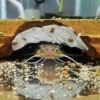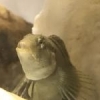I believe that it's not that much different except for adding and maintaining the specific gravity or salinity. My recommendation is to get a good hydrometer or refractometer. I use a Hanna Instruments version that's really accurate and easy. Once you determine what level you'd like to keep your tank at, then it's much easier to maintain if you know how much salt to add to a 5g bucket. Ideally, it's nice to mix your water in a large container, like a barrel or trash can especially if you want to be precise in keeping your salinity levels. I am eventually going to build a mixing station like this using RO/DI water, but I'm not doing it yet. I'd like to because of finding ways to automate things, and to make life easier, and maybe cut down on algae growth. Right now, I just mix my water in 5g buckets. Most native brackish fish can tolerate wide ranges of salinity. In fact, many species can tolerate pure saltwater or freshwater if acclimated slowly enough. Breeding them might require being more precise, but they're tough critters, with the ability to adapt to sometimes rapidly changing conditions. Point being, don't stress too much if your salinity levels change over time.
Another thing to remember is that when your water evaporates, replace it or top it off with freshwater. This will keep your salinity close to what you started with. As it evaporates, your salinity changes slightly. If you as salted water to the tank, you may maintain it at your current level or even increase it. To me, I don't care, the fish don't care, so I top off with FW.
Water changes are up to you. I try to do them once a month, but I'm lazy and may not get to it for 3 or even 6 months. I like my tanks to look as natural and wild as possible, so my tanks are far from pristine. If you want a clean pristine tank, do more water changes and keep fewer fish.
I am currently keeping 3 brackish tanks, one display tank and two QT tanks. I have a pretty heavy bioload and feed heavily. I offset that by growing macroalgae in my tank and in my sump's refugium. My ammonia and nitrite levels are zero, but nitrates are a bit high, but I don't keep corals, so everything works out find. For example, I think my 100g (140g w/the sump) has 45 fish, with 15 of them being benthic. The rest are always on the move and active, so probably produce a lot of nutrients. I also have probably 30 crabs and shrimp combined. All are doing well. I think finding the balance is up to you and depends on what you keep in your tank. Some people try adding grasses like eel, turtle or manatee grasses, or other brackish grasses to their tanks. I thought about it but really don't have room, but that's another consumer of nutrients.
I don't know much about keeping those particular species except that hogchokers are pretty tame, but adult ones may eat baby fish if you plan on breeding them in your display tank. They should be fine with the adults.
Keep us updated on your progress. I look forward to seeing some updates with pics and/or videos. Good luck!










